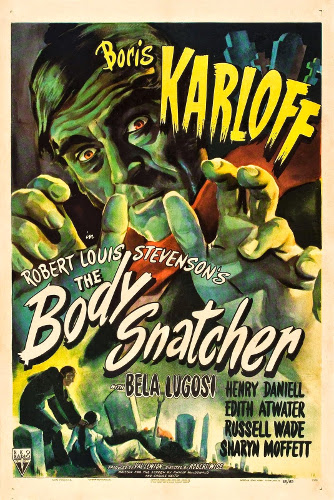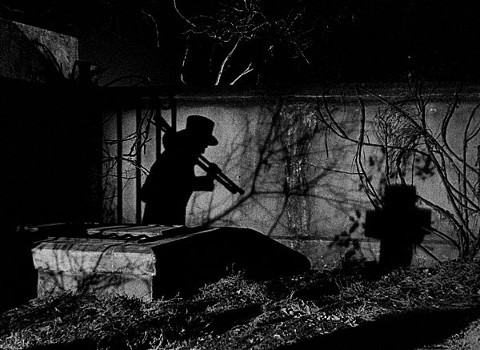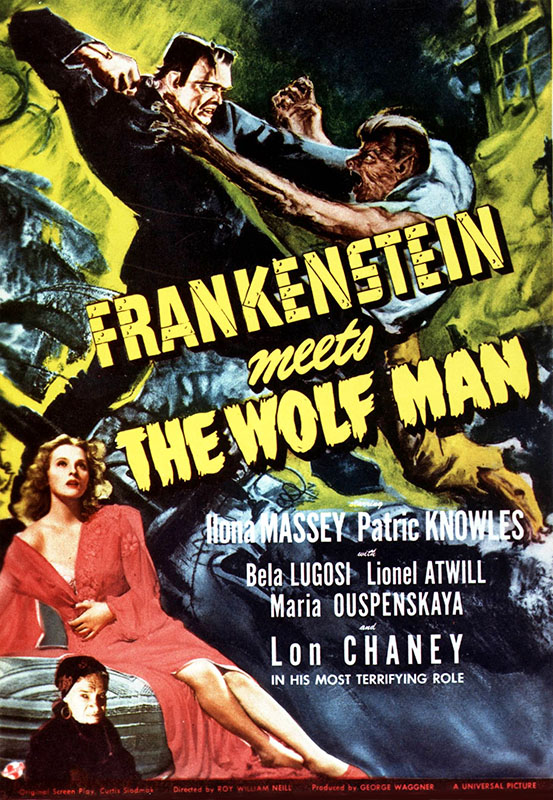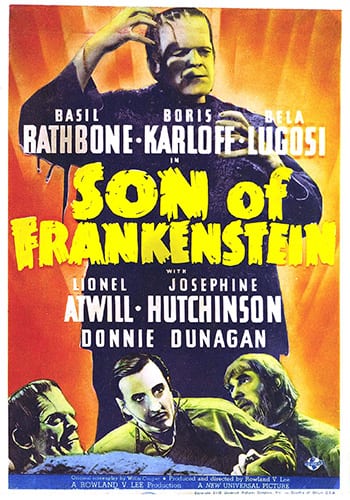The Body Snatcher
Directed by: Robert Wise
Written by: Philip MacDonald, Val Lewton
Starring: Bela Lugosi, Boris Karloff, Edith Atwater, Henry Daniell
USA
AVAILABLE ON DVD
RUNNING TIME: 78 mins
REVIEWED BY: Dr Lenera
Edinburgh 1831: medical student Donald Fettes is too poor to continue with his studies, so his lecturer Dr. Wolfe MacFarlane agrees to take him on as his assistant. Fettes is disappointed when MacFarlane refuses to perform an operation on a young paraplegic girl because he’s too busy, then disgusted when he learns that MacFarlane has been paying cabbie John Gray to supply him with stolen dead bodies for anatomical research. Gray seems to have some hold over MacFarlane, and then Fettes begins to realise exactly how Gray obtains these bodies….
The Burke and Hare murders were a series of sixteen killings committed over a period of ten months in 1828 in Edinburgh, Scotland, undertaken by William Burke and William Hare, who sold the corpses to Robert Knox for dissection at his anatomy lectures. These grisly deeds have understandably inspired quite a few films, the most recent being the comedic Burke And Hare in 2010 which was a major disappointment coming from John Landis. I’ve seen most of them, and have always rated 1960’s The Flesh And The Fiends [unofficially remade in 1985 as The Doctor And The Devils] as the best one. But of course I hadn’t seen Val Lewton’s version until now, and now I just can’t decide which is best. Both are very, very good. The first feature film which Robert Wise directed in its entirety is obviously less graphic than the later film, but of course that certainly doesn’t mean that it’s inferior, especially if you’re dealing with a Lewton production in which reticence is a strength. It was based on a short story of the same name by Robert Louis Stevenson, but is actually a sequel to the grisly facts that inspired it, and not just because it’s set afterwards and some of its characters refer to Knox, Burke and Hare. It’s probably the most all round entertaining of the Lewtons which makes it understandably that it’s also one of the most popular. It’s slightly different to the previous ones [as I think the final film Bedlam will also be], replacing subtle yet complex handling of what usually turns out to be the supernatural with fact-inspired, more ‘in your face’ happenings, much of the horror coming not from things like the ‘Lewton bus’ but the details of the story, though that’s not to say that there aren’t some tremendously chilling moments, especially a final scene that must have scared 1945 audiences silly.
Box office revenue from the series had been steadily declining, so after The Curse Of The Cat People was released to little success, RKO decided to hire Jack L. Gross, a distributor from Universal, to executive produce the rest of the films, and bring over Boris Karloff, still the biggest horror star at the time. Karloff had chosen not to renew his contract with Universal because he felt their films were getting too silly. Lewton was aghast at Karloff being forced upon him, largely because he didn’t think much of the films Karloff had been in of late, but then he was told that Karloff didn’t like the last few “horror” movies he had been in and loved the “terror” films that Lewton was doing, and the two subsequently hit it off. He later stated that Lewton was, “the man who rescued me from the living dead and restored, so to speak, my soul.” First up was Isle Of The Dead, for which long-time editor Wise, and the person who’d taken over the Curse Of The Cat People when the original director fell behind, was finally promoted to director, but when Karloff had to have a back operation, it took Lewton a while to reassemble everyone, so he and Wise decided to make The Body Snatcher in the interim. Philip MacDonald adapted the story, adding some characters and not having Fettes aid MacFarlane, though the MPAA found the script too gruesome and Lewton’s rewrite was so extensive that it was insisted he take credit – which he did under the pseudonym Carlos Keith. RKO then insisted on Bela Lugosi too, so Lewton wrote a role for him, though Lugosi’s ill health meant that he struggled to complete his few scenes. Exterior’ scenes were filmed on sets constructed for the 1939 version of The Hunchback of Notre Dame. The Body Snatcher went on to do excellent box office. In the UK, the BBFC cut seven minutes of references to Burke and Hare, a murder scene, and even the finale.
Some reasonable locale-setting [despite some stock shots not being of Edinburgh] leads us into a conversation in a graveyard between our hero and the mother of a recently deceased son whose dog has remained by his grave for several days, a direct reference to Scotland’s most famous canine Greyfriars Bobby who lay on his master’s grave for fourteen years till his death. Next we first meet Karloff’s character John Gray being really nice to a little girl as he carries her into MacFarlane’s surgery. Poor Georgina’s condition, brought on by a carriage crash which killed her father, means that she can’t walk and is getting progressively worse. She immediately finds MacFarlane frightening with his uncaring manner, but responds to Fettes’s more calm and compassionate way of communicating, something which introduces one of the film’s major themes, later spelt out in the line, “there’s a lot of knowledge in those eyes, but not a lot of understanding”. MacFarlane knows so much, but doesn’t have the empathy to be a great doctor. He also enjoys his lofty position in society so much that he hides his marriage to his maid Meg who’s below him in station. Also living in the large house that doubles as a surgery is Joseph, an assistant who’s always “sneaking around like a redskin”. Even though Lugosi certainly makes the most of a part which is so small it’s baffling to think that RKO could get away with him being second billed, it’s rather sad to see him reduced to this menial role, a sign of his standing in the movie industry at the time, but he does get two scenes with Karloff. The second one is highly memorable and a nice final one for the two of them who’d performed together many times before. Joseph visits Gray and tries to blackmail him, but Gray plies him with drink while telling us some important exposition, then, after saying “I’ll show you how they did it” referring to the Burke and Hare killings, smothers him to death, an act mostly shown at a distance but which goes on for longer than you’d expect.
MacFarlane needs the bodies that Gray procures for him, while Gray has something over him and keeps on turning up like a bad smell to bother him. Gray clearly chose scraping out a living over trying to become a good and successful person decades ago, yet he has pride and Karloff, as he often did, gives the character just a touch of pathos, even though the first of his visits to a graveyard that we see has him killing the dog, which even when done below the frame while Gray is in shadow is a real startler. It’s then followed by perhaps the most moving scene in all of Lewton when the mother who’s still grieving over her dead son is seen carrying the dog. Karloff is visibly relishing being given some literate dialogue to speak, though Henry Daniell, perhaps tired of playing villains in period pieces, is a tad stiff, even when his character tries to redeem himself by performing this previously never carried out operation on Georgina. It’s possible that some may see the whole Georgina subplot as unnecessary, and it is a bit sentimental, but – as I’ve said many times before – I don’t automatically see sentimentality as a flaw, and I think this subplot is a nice mirror to the darkness of what people are thinking and doing all around her, Georgina hoping for what is virtually a new life while dead bodies fuel much else of what is happening. Her belief, started by Gray, that a white horse will appear when she can start walking again, leads to delicious irony when Gray keeps appearing with his carriage being drawn by a different horse, and finally a wonderfully triumphant moment when Georgina overcomes her problem without even thinking about it. This material, not in the story, was obviously added to balance things out as well as to give Fettes a love interest [not that the latter is given enough time to properly register], but it worked for me.
Elsewhere, the corpses pile up and secrets are revealed as the central relationship becomes the one between MacFarlane and Gray, the latter being really the conscience of the former who’s plagued by guilt and might be losing his mind. “You’ll never be rid of me” says Gray at one point, and he proves to be right. The chilling finale sees Lewton pull off the sort of climax that EC Comics were later known for, though my favourite horror sequence is much earlier. Several times we’ve lingered on a woman singing a traditional Scottish song on a street corner for money, and at one point we’ve had a brilliant transition from her into an inn where a boy is singing a similar song. But eventually we get to when she walks alone down a deserted cobblestone street at night, still singing her song which is now almost unbearably melancholic. The camera is held on her as she walks under a bridge and disappears into the darkness on the other side. Without any cuts and from a distance, Gray’s horse and coach enter the frame, plodding slowly along in the girl’s wake. The coach disappears into the same darkness under the bridge. We then hear the girl’s song cut off at the end of a note with a slight squeak – and finally the shot cuts to the next scene. While I do most certainly love a lot of gory, visceral horror – I wouldn’t be writing for this website if I didn’t – there are many examples of when the subtle approach is the most effective and frightening, and this scene is a very good example of that. Wise, who don’t forget much later made the superb ghost movie The Haunting which had several genuinely spine chilling moments without showing anything except for that terrifying scene with the door, truly proves himself with this scene. Overall his direction isn’t that different from that of Jacques Tourneur and Mark Robson, clearly and understandably following the Lewton movie template fairly closely.
Dialogue tends to lean towards the droll. “You know anything about the human body?”, “I’ve had some experience”. “You’ll find the specimen in good condition, he was as bright and lively as a gazelle not a week long gone”. Karloff was born to deliver lines like this. Cinematographer Robert De Grasse lensed Lewton’s The Leopard Man to terrific effect, so I was greatly looking forward to see what he would come up with for The Body Snatcher. In keeping with the somewhat more realist tone of the picture, De Grasse’s work here is less expressionistic, yet there’s still much creative use of black, and sometimes said black is very menacing, constantly threatening to draw many of the characters into the abyss. Russell Wade is your typical dull Lewton ‘hero’ and seeing the American cast trying to get their tongues around the commendably Scottish-style dialogue is pretty laughable at times, with only Edith Atwater adopting a proper accent. But then of course this film was made at a time when this approach was the norm and few would have cared. As for Karloff – I love you and you’ve been one of my favourite actors since I was very young, but let’s face it – your attempt at an accent in a few scenes while not bothering elsewhere isn’t particularly great. Roy Webb’s music score is very sparsely spotted and unlike the accents is in great contrast to the fashion of the time. His Scottish-flavoured main theme is very pleasant. Intelligent yet also containing a real fun factor which is not very prominent in the other Lewtons as fine as they are, The Body Snatcher was thoroughly enjoyed by Yours Truly, who would [there are two to go and I don’t think either of them will change my mind] rank third best out of the Lewton series, just behind the two masterpieces that are I Walked With A Zombie and The Curse Of The Cat People.










Be the first to comment